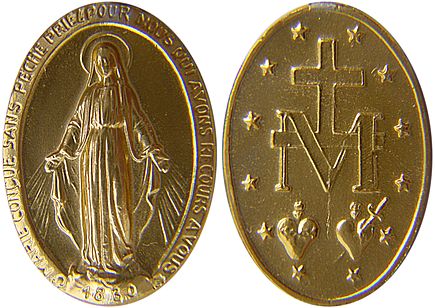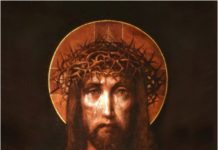November 27th is the anniversary of the apparition of the Blessed Virgin Mary to Saint Catherine Labouré (1806 – 1876), a Visitation Sister, during her evening meditation. Our Lady was so real, reported Sister Catherine, that she could feel the folds on her dress, and whose beauty she could not describe. The Mother of God tasked Catherine with spreading devotion to her intercessory power:
God wishes to charge you with a mission. You will be contradicted, but do not fear; you will have the grace to do what is necessary. Tell your spiritual director all that passes within you. Times are evil in France and in the world
She was to have a medal forged, in accord with how Our Lady appeared, and we may be familiar with the once-nearly-ubiquitous medal, which soon gained the name ‘miraculous’ from all the favours granted via this sacramental. We may be familiar with its design, specified by Mother Mary herself: the Virgin upon a globe, crushing the head of the serpent, with rays from her hand (signifying the ‘graces, for which many forget to ask’, as Our Lady put it), with two hearts within a the large ‘M’, and the cross, with the prayer ‘Ô Marie, conçue sans péché, priez pour nous qui avons recours à vous (“O Mary, conceived without sin, pray for us who have recourse to thee”. All deeply symbolic and powerful.
One may be tempted to discount such a medal; what can such a piece of metal do? Yet sacramentals have their power, and we should do what Our Lady says. Recall the words of Elisha to the leper Naaman, to bathe in the Jordan seven times. Naaman was himself tempted to forego such a paltry exercise – were there not much grander rivers in his native Syria? Yet, his servant advised him to do what the servant of God said. And what more reliable servant of God than His own mother?
The medal is a remedy for evil, in our own hearts, and in the world. If times were evil in 1830 – and they were – what are we to say of our own days? Even though evil will be with us to the end, and we may one day witness its ‘final unleashing’ as the Catechism says, we always have recourse to Mary and all the saints. When Catherine saw colourful rays beaming from Our Lady’s hands, she asked what they were: They were the graces offered to the world. Catherine noticed that there gaps, and Our Lady said those were graces for which no one requested. How much grace there is for the asking!
Catherine’s spiritual director was at first skeptical, but eventually took the Sister’s claims, and the design for the medal to the bishop, who agreed to have a small number of them made, without approving the supposed visions. To his surprise, the demand was far beyond what he had expected, and has never stopped since. There are now billions of such medals, making miracles, large and small.
After the visions, Catherine led a life of obscurity, tending the sick at another convent in Paris, for Our Lady had asked her to tell no one, except her spiritual father – she lived Saint Philip’s maxim of amare nesciri – love to be unknown – to its full. No one ever knew it was Catherine, until after her death at 70. Her body was exhumed soon after, and found incorrupt, and brought in grand procession back to her convent at Rue du Bac, where she rests still, beside that of Saint Louise de Marillac, who had co-founded the Daughters of Charity with Saint Vincent de Paul. Sister Catherine Labouré was canonized in 1947 by Pope Pius XII.
On that note, the chapel where the visions took place, at the convent of the Daughters of Charity in the Rue de Bac in Paris, is still a very popular place of pilgrimage, and is where the incorrupt bodies of Saint Catherine, along with reside, awaiting the resurrection.
So fear not, dear reader, and hold your head high, for if we but keep faith, not a hair of our head – that is, our eternal salvation – will be lost.
Here is a short documentary on our saint, well worth a watch. Wait for the bit about the atheist Alphonse Ratisbonne – a propos to our own day – and I had not fully realized the connection also with John Henry Newman and, of course, the later appearance of Our Lady at Lourdes, confirmed that was indeed ‘conceived without sin’. Hopefully inspire readers to wear their medal, as Our Lady asked, or wear it with greater devotion if they already do:












